Overview
Within This Page
Integration of information technology and building architecture calls for a robust, global, and secure infrastructure that will support the growing and evolving demands of business and government in the 21st century.
To stay in business, organizations have to stay current, purchasing the appropriate server, database, media, network equipment, and other technologies that sustain their activities. They must leverage these evolving information technologies to match the specifications of their stakeholders.
Interoperability across building systems—including power, HVAC, lighting, security, and fire alarm—should enable whole building control and performance optimization. Assuring flexibility to accommodate the dynamic nature of telecommunications systems starts first and foremost with properly designed pathways and spaces.
Demands on the building's data pathways are heavy, and the market is strong for high performing buildings having:
-
Power supply systems that provide flexible service; reliable, clean power; and can adjust power delivery to building occupation patterns. Power issues to consider may include: utilities, water, distribution, sewage, medical gases, fuel supply, and fuel systems to name a few
-
Wire management systems that enable quick and low-cost reconfiguration;
-
Adequate and properly located dedicated space and utilities to accommodate data/communication, audiovisual connections and requirements needed in conference rooms/media space, and distribution systems.
-
Adequate space and ergonomically configured equipment/furnishings for work, printing, and processing stations.
-
Integration of wireless products as appropriate and necessary; and
-
Distributed computing environments that have reliable cooling compatible with human comfort.
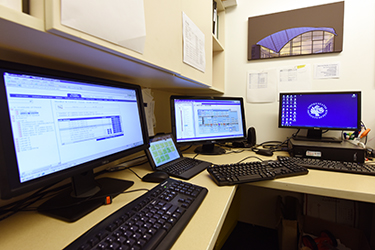
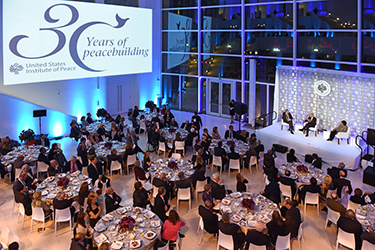
Computers in the engineer's office at the US Institute of Peace, help manage and monitor the building and its systems and support and adapt to the variety of events that are organized there on a regular basis.
Recommendations
Provide Distributed Data, Power, Security, Voice, Video, and Environmental Services for Central Communications and Continuity of Operations
-
Assure that technological solutions respond to the changing nature of work. (See also WBDG Changing Nature of Organizations, Work, and Workplace).
-
Include an information technologies engineer in the project planning and design process.
-
Consider wireless and mobile technologies to support the changing nature of work, including both internal and external ability.
-
Provide distributed Uninterrupted Power Supply (UPS) for clean and reliable power.
-
Merge all low voltage systems, including data and voice, through distributed Ethernet-IP networks with centralized backup.
-
Monitor work environmental conditions with central systems, but maximize local control by occupants.
-
Consider desktop video and Internet-based conferencing to provide on-going contact for dispersed work groups.
-
Investigate direct current power distribution for improving energy efficiency and increasing design and space flexibility.
-
See also WBDG Productive—Assure Reliable Systems and Spaces.
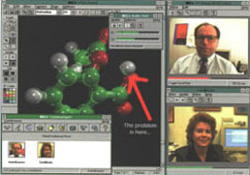
Desktop video conferencing
Photo Credit: openSYNTHESIS formerly MDL Corp.
Design Accessible, Modifiable, Vertical Power, and Telecom Cores
-
Provide modular power panels with appropriate open riser space.
-
Consider state-of-the-art technologies to provide secure, high-speed access to the desktop for data, voice, security, and environmental information (e.g., fiber optics, wireless, copper).
Employ Distributed Modular Cabinets with Plug and Play Interfaces
-
Provide modular racks and plug-in hardware within office suites versus closets and hard wiring.
-
Design service neighborhoods to meet or exceed current standards.
-
Manage wiring under floor or vertically through patch panels.
-
House servers, network equipment, etc. in environmentally controlled modular cabinets.
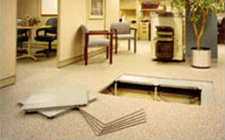
Under floor air distribution system installed in a renovated facility.
Provide Re-Configurable Plenum Systems
-
Consider overhead cable trays and/or underfloor wire baskets for increased flexibility and accessibility.
-
Optimize plenum real estate. Conduct a multidiscipline "charrette" with structural, fire, networking, HVAC, interiors to integrate systems. Consider the need to maintain air seal of underfloor air plenums as power and communications wiring changes are made over the life of the facility.
-
Use 3D modeling and BIM technologies to facilitate integration, validate and monitor performance of the facility against metrics set at the time of commissioning.
-
Simplify the ease of relocating modular boxes in relation to ceiling, floor, and carpet tiles.
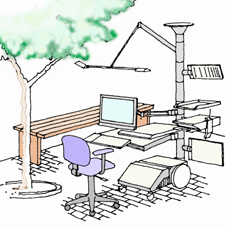
Mobile office for the intelligent workplace—well-applied technology can ensure a leap in both technical and environmental quality, enabling every worker to have the very best in environmental conditions.
Photo Credit: Center for Building Performance & Diagnostics, Carnegie-Mellon University
Design Kit-of-Parts for Efficient, Modifiable Services
-
Base capacities on maximum occupancies, but distribute and deliver as needed.
-
Select terminal units that provide services—data, power, and voice (and environment where possible)—in reconfigurable boxes for just-in-time modifications.
- Provide relocatable modular outlet boxes with flex connectors to respond to changing densities.
- Bring services to the desktop as required by users.
-
Select systems to be compatible with Internet-based applications.
Select IT System and Components for Energy and Material Conservation
-
Design for longevity (expandability, disassembly, recyclability), maintainability, and energy and material efficiency.
-
Consider sub-metering of power to address customer requirements for tracking energy usage.
-
Follow recommendations and guidelines for energy efficient data centers.
-
Employ smart building technologies, energy management systems (EMS), and Building Automation Systems (BAS).
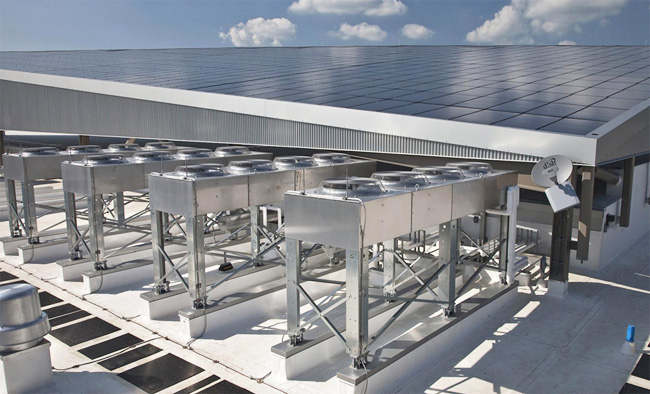
The Emerson Global Data Center incorporated a 7,800 square-foot solar rooftop array as part of their sustainability strategy to improve the energy efficiency and reduce the footprint of the building.
Relevant Codes and Standards
- National BIM Standard—United States™
- Telecommunications Industry Association (TIA)
- Department of Defense
- U.S. General Services Administration
Additional Resources
Organizations
- Audiovisual and Integrated Experience Association—The international trade association representing the audiovisual industry.
- The Gensler Research Institute—A network of researchers with a singular focus: developing a deeper understanding of the connection between design, business, and the human experience.
- HOK—A global design, architecture, engineering and planning firm specializing in design research and thought leadership.
- Internet Engineering Task Force (IETF)—A large open international community of network designers, operators, vendors, and researchers concerned with the evolution of the Internet architecture and the smooth operation of the Internet.
- Lighting Research Center—The Lighting Research Center at Rensselaer Polytechnic Institute is the world's leading center for lighting research and education-pioneering research in solid-state lighting, light and health, transportation lighting, and energy efficiency.
- National Research Council Canada—The Government of Canada's largest research organization supporting industrial innovation, the advancement of knowledge and technology development, and fulfilling government mandates.
Trade Shows
- Greenbuild International Conference and Expo—The world's largest conference and expo dedicated to green building.
- IFMA's World Workplace—The most all-encompassing learning and networking event on facilities and how to manage them.
- NeoCon-Trade fair for interior design and facilities management
Publications
- Buildings (formerly ARCHI-TECH magazine)
- Greening Federal Facilities: An Energy, Environmental, and Economic Resource Guide for Federal Facility Managers and Designers, Department of Energy. May 2001.
- High Performance Commercial Buildings—A Technology Roadmap by U.S. Department of Energy. June 2001.
- The Integrated Workplace: A Comprehensive Approach to Developing Workspace by Office of Real Property in the Office of Government-wide Policy of the U.S. General Services Administration. May 1999.
- Workplace Matters , Public Buildings Service, Office of Applied Science of the U.S. General Services Administration. 2006.








